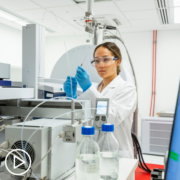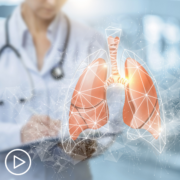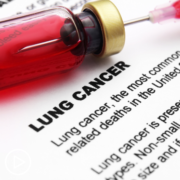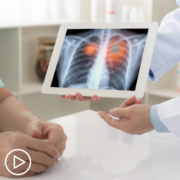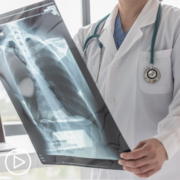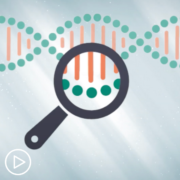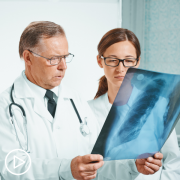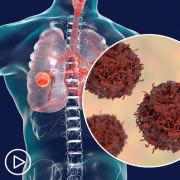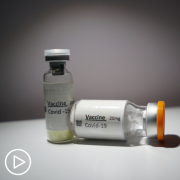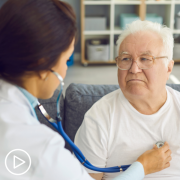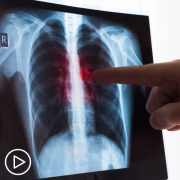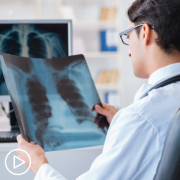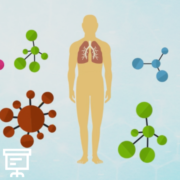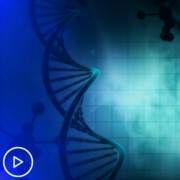Which Tests Do You Need Following a Lung Cancer Diagnosis? from Patient Empowerment Network on Vimeo.
Which lung cancer tests do patients need after a diagnosis? Expert Dr. Heather Wakelee provides an overview of lung cancer testing, explains how the results are used, and discusses how testing differs for small cell lung cancer versus non-small cell lung cancer.
Dr. Heather Wakelee is a thoracic medical oncologist and deputy director of the Stanford Cancer Institute where she also serves as the division chief of medical oncology. Learn more about Dr. Wakelee, here.
See More From INSIST! Lung Cancer
Related Resources:
Transcript:
Katherine:
Can you provide an overview of important tests following a lung cancer diagnosis?
Dr. Wakelee:
That’s a fabulous question. When we think about the tests that we need to have done, they’re mostly tests that are done on the tumor, so, either if someone has a surgery or at the time of biopsy. and, that’s where we can figure out what we call, again, the histology that’s squamous or non-squamous. That’s when they look at it under the microscope. But, they also, with the tumor specimen, you can pull the DNA out of the tumor and then test for the gene mutations in the tumor. And, I always emphasize these are not changes in the genes that are in the whole person. They are things that are unique to the tumor. They are what make the tumor different from the rest of the person.
So, we look at those gene mutations, or that’s kind of a biomarker. So, there are a lot of terms that we use, and I know it gets really confusing. So, I try to use “biomarker” to mean all of these things, but that gene mutation is what we look at in the tumor tissue to see if there are specific changes that will allow us to give a pill therapy, a targeted pill therapy. And then, there are also aspects of the tumor that help us figure out whether or not the immune therapy might work, and most commonly, that’s something called PD-L1. That’s a protein that we look at on the surface of the tumor, and so again, under the microscope.
Katherine:
And, when you talk about extracting DNA, is that via a blood test?
Dr. Wakelee:
So, we have two different ways to do that. So, what I was talking about before was from the tumor tissue, you can extract the DNA. But now, there are these liquid biopsies where we can draw blood and find the tumor DNA that is different from the rest of the person’s DNA and look for those gene mutations in the tumor.
And that is where there’s a lot of developments happening. And, that’s so fabulous because they’re often faster results for patients, and it means that you cannot have to go through another biopsy. We still need the biopsy to establish whether or not there is even cancer. But, once we know that there’s cancer for sure, then we can use the liquid biopsies to get a faster information result on those gene mutations and to follow over time to see how the tumor evolves because tumors change after they’ve been treated.
Katherine:
Do you use imaging at all?
Dr. Wakelee:
Yes. Always. So, when someone is first diagnosed with cancer, we usually find that because of imaging, so, a CT scan or an X-ray, maybe they had a screening CT scan or maybe they had a cough that led someone to go get an X-ray, an examination. So, the imaging is a part of the original diagnosis. And in addition to CT scans, we’ll often get a PET scan that helps us look for, in a different way, the rest of the body, maybe an MRI of the brain to look in that area.
And then, wherever we’ve found the tumor, we will track that area with scans over time. And, it gets a little complicated for a patient that was found with what we call early-stage disease. So, stage I or II. Many of the times, those patients can have surgery and then we don’t have any tumor we can follow anymore. But we get CT scans to look to see if it could have come back. For patients with more advanced disease, so, stage III that couldn’t have surgery or stage IV, there we have areas that we’re going to continue to follow with the scans. And which scans and how often is going to depend a lot on what treatment the patient’s on and where the tumors are located that we’re tracking.
Katherine:
Do these tests differ for small cell lung cancer and non-small cell lung cancer patients? And, I know that non-small cell lung cancer is also known as NSCLC.
Dr. Wakelee:
Yes. So, long ago, the only distinction we had with lung cancer was that small cell versus non-small cell, and that is something that is seen under the microscope when that tissue is taken out from the biopsy. The pathology doctors look at it under the microscope, and the cells look different. And, the small cell lung cancer, those cells are small. It’s not very creative naming. And then, everything else is non-small cell or NSCLC. So, it’s SCLC and NSCLC. So, that was one of the first distinctions.
And, it is still very important because the chemotherapy drugs that we use are slightly different. And, the genetic, those gene mutations, we see them in any cancer. That’s what makes a cancer different from the rest of the body. But in small cell lung cancer, the tumor mutations that we see are not things that we know how to target specifically. In non-small cell, there are targets that we can target specifically for some patients.
So, just there, it’s different in having the targeted pill drugs in non-small cell, not so much in small cell. With immune therapy, those newer immune therapy IV drugs, they can work in both small cell and non-small cell.
But for small cell, the biomarkers, that PD-L1 level is not as important for helping us figure out who’s going to benefit. For non-small cell, with many of the drugs, it is important. So, there are differences there.
